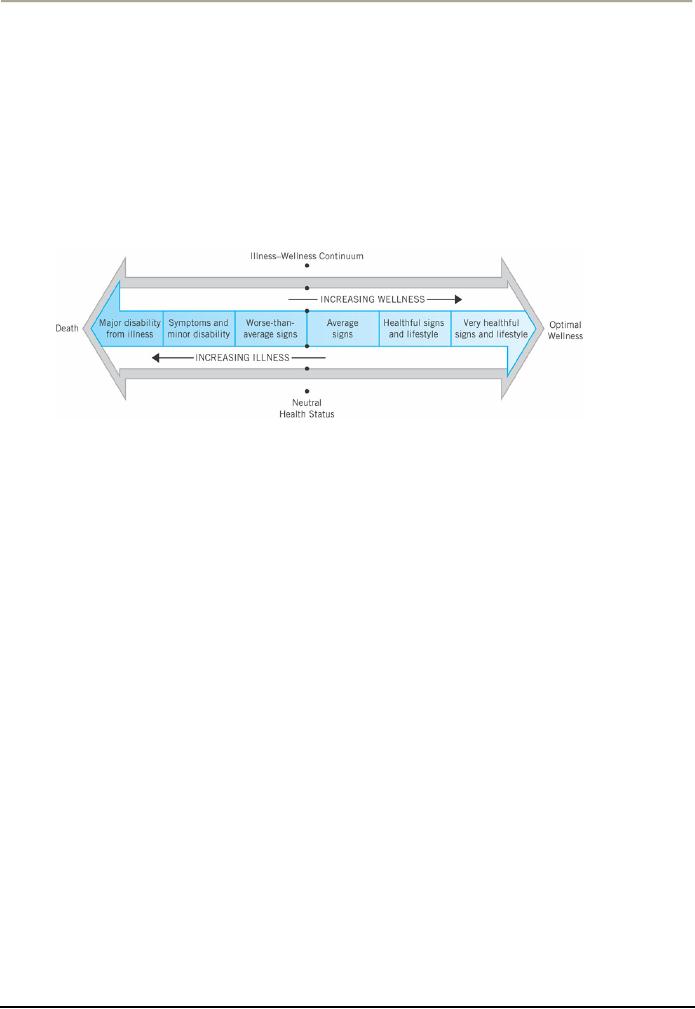 |
INTRODUCTION TO HEALTH PSYCHOLOGY:Health and Wellness Defined |
| INTRODUCTION TO HEALTH PSYCHOLOGY:Early Cultures, The Middle Ages >> |

Health
Psychology PSY408
VU
LESSON
01
INTRODUCTION
TO HEALTH PSYCHOLOGY
Prologue
"Wide
load" the boys shouted as they
pressed themselves against the
walls of the hallway at school.
They
were
`making room for a very overweight
girl named Sara to pass
through. Lunch time in the cafeteria
was
even
more degrading for Sara
because when she sat down to
eat; her schoolmates would
stop eating, stare at
her
every move, and make
pig noises. "Kids can be
cruel." her parents would
say to console her. One
of
Sara's
aunts told her that
she inherited a glandular problem, and
you can't do anything about
it." and
another
aunt said, "You'll lose weight
easily in a couple of years
when you start getting
interested in boys."
Is
either aunt right?
Sara's
parents are concerned about
her weight because they know
that overweight people often have
social
problems
and face special health
risks, particularly for high
blood pressure and heart
disease. But her
parents
are not sure why
she is so heavy or how to
help her. Although her
father is a bit overweight,
her
mother
is very heavy; was heavy as a
child, and did not
lose weight when she became
interested in boys.
This
could support the idea of an inherited
cause of her being overweight. On the
other hand, they know
Sara
eats a lot of fattening
foods and gets very little
exercise, a combination that
often causes weight
gains.
As
part of their effort to
change these two behaviors,
they encouraged her to join a
recreation program,
where
she will be Involved in many
physical activities.
This
story about Sara illustrates
important issues related to health.
For instance, being overweight is
associated
with the development of specific health
problems and may affect the
individual's social
relations.
Also,
weight problems can result
from a person's inheritance and
his or her behavior.
What
is Health?
What
is health? How do you know
when you are healthy? To
answer these questions,
let's first consider
what
illness is. We define a disease as a
characteristic grouping of physical
signs and symptoms; it is given
a
specific
name and can often be
traced to a specific causal
agent. Illness, however, is a broader term
that
involves
people's beliefs about the state of
their physical well-being and the
resulting behaviors they engage
in.
Illness
beliefs may be the result of a
specific disease or just the
way we feel when we say we are
ill (even
when
there is no evidence of a
disease).
Illness
is important because it is what motivates
people to seek out a physician. A
disease is what the
physician
recognizes as a specific disorder based
on known signs and symptoms.
Therefore, a physician is
likely
to define health as the absence of disease,
while the average person
might define health more
broadly;
as
the absence of any ill
feelings.
In
both of these definitions, however,
health is described in terms of what it is
not--as the absence of
disease
or illness.
We
commonly think about health in terms of an
absence of
(1)
Objective signs that the
body is not functioning
properly, such as measured
high blood pressure,
or
(2)
Subjective symptoms
of
disease or injury, such as pain or
nausea.
Dictionaries
define health in this way, too.
But there is a problem with
this definition of health. Let's
see
why.
Consider
Sara, the overweight girl in the opening
story. You've surely heard people
say. "It's not healthy
to
be
overweight," Is Sara healthy?
What about someone who feels
fine but whose lungs
are being damaged
from
smoking cigarettes or whose arteries
are becoming clogged from
eating foods which are high
in
1

Health
Psychology PSY408
VU
saturated
fats? These are all
signs of improper body
functioning. Are people with
these signs healthy?
We
probably
would say they are not
"sick"--they are just less healthy
than they would be without
the
unhealthful
conditions.
This
means health and sickness
are not entirely separate
concepts--they overlap. There are degrees
of
wellness
and of illness. Medical
sociologist Aaron Antonovsky
(1979, 1987) has suggested
that we consider
these
concepts as ends of a continuum,
noting that "We are
all terminal cases. And we
all are, so long as
there
is a breath of life in us, in some
measure healthy". He also
proposed that we revise our
focus, giving
more
attention to what enables people to stay
well than to what causes people to
become ill.
The
Illness-wellness Continuum
In
this way, health refers to a positive
state of physical, mental,
and social wellbeing--not simply
the
absence
of injury or disease--that varies over
time along a continuum. At the wellness
end of the
continuum,
health is the dominant state. At the
other end of the continuum, the
dominant state is illness
or
injury,
in which destructive processes
produce characteristic signs,
symptoms, or disabilities.
Health
and Wellness Defined
In
1947, the World Health Organization
(WHO) defined health as "the
state of complete mental,
physical,
and
social well-being, not merely the
absence of disease" (WHO,
1947). WHO's definition was
the first
globally
accepted conceptualization of health and stood the
test of time for more than a
decade.
Although
multifaceted, this definition of health was flawed,
according to members of a new
movement
called
holistic health. The holistic health
movement came into being in the 1960s as
an attempt to expand
the
view of health that WHO had
spread.
One
of the early pioneers in the field,
Halbert Dunn (1962), believed
that WHO'S vision of
health
characterized
it as a static state. Rather
than call health a state of well-being,
Dunn preferred to view it as a
continuum.
Developing and maintaining a high level
of health means moving toward
high-level functioning
along
a continuum that starts with
low-level wellbeing and ends
with optimal functioning.
Health is a
conscious
and deliberate approach to
life and being, rather than
something to be abdicated to doctors
and
the
healthcare system. Optimal health is a
result of your decisions and
behavior.
In
addition, Dunn recast the
notion of wellbeing to revolve around how
well a person functions. That
is, he
viewed
functioning as evidence of well-being.
Although people will have
setbacks in their quest for
optimal
functioning,
the direction in which their
lives are moving becomes an
important criterion for
evaluating
their
wellbeing. In this movement, daily habits
and behaviors, as well as
overall lifestyle, assume primary
importance.
Originally,
the scope of well-being was limited to
three dimensions: physical,
social, and mental.
Adherents
of
holistic health argued that the
mental dimension has two
components--the intellectual (rational
thought
processes)
and the emotional (feelings and
emotions). Each of these
domains deals with a
different aspect
of
psychological well-being. An additional dimension, the
spiritual, was added because it
was thought that
2

Health
Psychology PSY408
VU
humans
could not function optimally in a
spiritual vacuum. Therefore, the holistic
definition of health has
five
dimensions: physical, social, emotional,
intellectual, and spiritual.
In
the 1970s and 1980s, the
definition of health was expanded
once again by the wellness
movement
(Ardell,
1985). Wellness is an approach to health
that focuses on balancing the
many aspects or
dimensions
(physical,
social, spiritual, emotional, intellectual, and
environmental/occupational) of a person's
life by
increasing
the adoption of health-enhancing conditions
and behaviors rather than by attempting
to
minimize
conditions of illness (AAHE,
2001).
A
key element of the wellness model is
striving for balance. When
all of the six dimensions
are at high levels
and
in balance, we have optimal health
and well-being. When the dimensions
are out of balance or one
is
severely
lacking, we have lower
levels of health and well-being.
Another
important part of wellness is the
process of becoming healthier. The
journey (becoming the
best
one
can be) is more important
than the ending. The process of wellness
involves becoming
increasingly
more
aware of health and making healthy
choices.
The
Six Dimensions of
Wellness
Physical
The
first dimension, physical well-being, is
reflected in how well the
body performs its intended
functions.
Absence
of disease--although an important influence--is
not the sole criterion for
health. The physical
domain
is influenced by your genetic
inheritance, nutritional status,
fitness level, body composition,
and
immune
status, to name just a few
factors.
Intellectual
Intellectual
well-being is the ability to process
information effectively. It involves the
capability to use
information
in a rational way to solve
problems and grow. This
dimension includes issues such as
creativity,
spontaneity,
and openness to new ways of
viewing situations. To maintain a high
level of intellectual well-
being,
you must seek knowledge and
learn from your experiences.
Ideally, your college
experiences will have
added
to your intellectual well-being (Figure
1.4).
Emotional
Emotional
well-being means being in touch with
your feelings, having the ability to
express them, and
being
able
to control them when necessary. Optimal
functioning involves the understanding that emotions
are the
mirror
of the soul. Emotions help us
get in touch with what is
important in our lives. Our
emotions make
us
feel alive and provide us with a
richness of experience that is
uniquely human.
Social
Social
well-being involves being connected to
others through various types
of relationships. Individuals
who
function
optimally in this domain are able to
form friendships, have intimate
relationships, give and
receive
love
and affection, and accept
others unconditionally. They
are able to give of themselves
and share in the
Joys
and sorrows of being part of a
community. This community includes
both formal and
informal
networks.
Formal networks include organizations such as
churches, professional organizations,
fraternities,
sororities,
and campus groups requiring
official membership, dues,
and standards. Informal networks,
such
as
an intramural sports team, do
not have rigid rules
for membership. In a sense,
your social networks are
a
major
part of your
environment.
Spiritual
Spirituality
is a belief in or relationship with some
higher power, creative force, divine
being, or infinite
source
of energy (Fowle; 1986). This
belief is manifested in a sense of
interconnectedness, a feeling that
somehow,
some way, we are all in this
together. For people whose spirituality
is religion- based, it is
ecumenical
in scope. It is part of but
transcends individual religions. Those
whose spirituality is
religion-
3

Health
Psychology PSY408
VU
based
believe in a supreme being or higher
supernatural force and subscribe to a
formalized code of
conduct.
For individuals whose
spirituality is secular, it is universal
or even extraterrestrial. In a
secular
sense,
spirituality could manifest itself
through connection to something greater
than oneself. Whether it is
being
part of a community, working to
save the environment, helping to
feed the needy, or being
committed
to world peace, the underlying feeling is
a perception of life as having meaning beyond the
self
(Richards
& Bergin, 1997).
Spirituality
is a two-dimensional concept. The first
dimension relates to one's relationship
with the
transcendent
(a connection with a higher being or power). The
second dimension is connected to
one's
relationship
with the self, others, and
the environment. A continual
interrelationship links the
two
dimensions.
Feeling connected with a higher power or being
gives us faith and hope and
helps us believe we
can
do things to make life meaningful. Believing in
oneself and feeling connected
with others and
one's
community
empowers us to act. Those
with a high level of spiritual health
behave in an interconnected way
(Harris
et al., 1999). They take
part in church and/or community
activities. They help
others. They get
involved
in causes and groups that
are proactive, whether it involves
cleaning up a vacant lot or a
beach
with
an environmental group or visiting the
sick and infirm who
arc hospital bound. It is in the "doing"
that
some
of the greatest benefits of spirituality
are derived (Harris et al.,
1999; Richards & Bergin,
1997).
Environmental
Environmental
well-being involves high-level
functioning on two levels.
The most immediate
environment,
the
micro-environment, consists of your
school, home, neighborhood,
and work site. The people
with
whom
you interact in those places
link the environment to the social
aspects of your health. This
environment
greatly affects your overall
health and personal safety by
influencing whether you are at risk
for
and
fear issues such as theft,
crime, and violence. The
quality of air and water, noise
pollution, crowding,
and
other issues that affect
your stress level are also
included.
Your
social support system is
also part of this environment.
The macro-environment, the level of wellbeing
at
a larger level--state, country,
and the world at large--also
affects wellness. The wars
in Iraq and
Afghanistan,
the terrorist attacks of September 11,
2001, and other issues
such as violence, international
disputes,
racism, sexism, heterosexism,
and ageism--all influence us daily to
some extent. When this
book's
authors
were in college, the Vietnam War
was going on. College-age
men started each day by
reading the
newspaper
to see which draft numbers were being
called up (all draft-eligible men
were issued draft
numbers)
and if any of their friends
were killed or missing in action.
Decisions that our political
leaders
make,
such as engaging in wars or determining
where we store radioactive wastes, affect
the way we think
and
live our lives. Our
ability to stay focused and
whole is constantly challenged by the
media, which bring
the
entire world and its
problems into our living
rooms each night. We need to
learn to think globally,
act
locally,
and be happy despite the myriad of
problems in the world.
Occupational/Vocational
Occupational/vocational
well-being involves issues related to
job wiliness. It encompasses everything
from
the
safety of your particular work
site to the nature of your
career. Work-site well-being includes
both
physical
(e.g., air, water, physical
plant, machinery) and social
(e.g., relationships with
coworkers,
management,
health and wellness facilities and
activities) factors. Your personal
wellness is affected by the
health
of your work site. Employers
and work sites vary
tremendously in relation to health. Some
strive for
optimal
levels, encouraging employees to
take advantage of a myriad of
health-enhancing programs
and
services.
Others merely meet the minimum
acceptable standards for health
and safety set by the
government.
Besides
the specific health of the workplace,
different jobs pose varying
threats to individuals' wellbeing as
a
result
of the nature of the work. Some
jobs, such as police and
military service, are risky
because of possible
exposure
to hostile combatants. Other occupations,
such as those of firefighters, emergency
medical service
workers,
coal miners, arid oil rig
operators, are risky because they
place employees in
dangerous
environments.
Still other occupations are
characterized by high stress
due to deadlines, competition,
or
other
factors.
4
Table of Contents:
- INTRODUCTION TO HEALTH PSYCHOLOGY:Health and Wellness Defined
- INTRODUCTION TO HEALTH PSYCHOLOGY:Early Cultures, The Middle Ages
- INTRODUCTION TO HEALTH PSYCHOLOGY:Psychosomatic Medicine
- INTRODUCTION TO HEALTH PSYCHOLOGY:The Background to Biomedical Model
- INTRODUCTION TO HEALTH PSYCHOLOGY:THE LIFE-SPAN PERSPECTIVE
- HEALTH RELATED CAREERS:Nurses and Physician Assistants, Physical Therapists
- THE FUNCTION OF NERVOUS SYSTEM:Prologue, The Central Nervous System
- THE FUNCTION OF NERVOUS SYSTEM AND ENDOCRINE GLANDS:Other Glands
- DIGESTIVE AND RENAL SYSTEMS:THE DIGESTIVE SYSTEM, Digesting Food
- THE RESPIRATORY SYSTEM:The Heart and Blood Vessels, Blood Pressure
- BLOOD COMPOSITION:Formed Elements, Plasma, THE IMMUNE SYSTEM
- SOLDIERS OF THE IMMUNE SYSTEM:Less-Than-Optimal Defenses
- THE PHENOMENON OF STRESS:Experiencing Stress in our Lives, Primary Appraisal
- FACTORS THAT LEAD TO STRESSFUL APPRAISALS:Dimensions of Stress
- PSYCHOSOCIAL ASPECTS OF STRESS:Cognition and Stress, Emotions and Stress
- SOURCES OF STRESS:Sources in the Family, An Addition to the Family
- MEASURING STRESS:Environmental Stress, Physiological Arousal
- PSYCHOSOCIAL FACTORS THAT CAN MODIFY THE IMPACT OF STRESS ON HEALTH
- HOW STRESS AFFECTS HEALTH:Stress, Behavior and Illness, Psychoneuroimmunology
- COPING WITH STRESS:Prologue, Functions of Coping, Distancing
- REDUCING THE POTENTIAL FOR STRESS:Enhancing Social Support
- STRESS MANAGEMENT:Medication, Behavioral and Cognitive Methods
- THE PHENOMENON OF PAIN ITS NATURE AND TYPES:Perceiving Pain
- THE PHYSIOLOGY OF PAIN PERCEPTION:Phantom Limb Pain, Learning and Pain
- ASSESSING PAIN:Self-Report Methods, Behavioral Assessment Approaches
- DEALING WITH PAIN:Acute Clinical Pain, Chronic Clinical Pain
- ADJUSTING TO CHRONIC ILLNESSES:Shock, Encounter, Retreat
- THE COPING PROCESS IN PATIENTS OF CHRONIC ILLNESS:Asthma
- IMPACT OF DIFFERENT CHRONIC CONDITIONS:Psychosocial Factors in Epilepsy